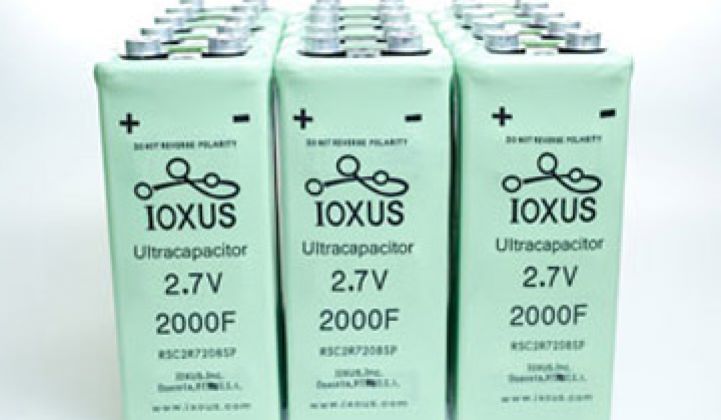Ultracaps can't do everything. But they will be everywhere.
Oneonta, N.Y.-based Ioxus -- which announced it raised $21 million in a second round of funding today -- plans to expand its manufacturing capacity from 20,000 ultracaps a month to 200,000 a month a year from now while continuing to drive down the price, said CEO Mark McGough in an interview.
Ideally, that move will solidify the position of ultracaps in existing markets like wind and portable lights while conquering new ones.
In transportation, for instance, manufacturers will increasingly insert ultracaps into regular cars, electric vehicles and hybrid buses to assist the engine or battery pack during stops, starts and acceleration. Forklift manufacturers will also adopt ultracaps to handle quick bursts of power. You may not see an ultracap-based car soon, but you will see ultracaps in vehicles, nonetheless.
Additionally, datacenter designers have begun to look at ways to incorporate ultracaps into their power delivery architectures.
"They are starting to be designed into UPSes," he said. "It's not widespread yet but we're at a tipping point, particularly as the price comes down."
Ioxus, meanwhile, will have friends to help it get into these markets. Investors in this latest round read like a who's who of industrial manufacturers. Energy Technology Ventures, a joint venture between General Electric, Conoco-Philips and NRG Energy, is an investor. So is Aster Capital, an investment vehicle for Alstom and Schneider Electric.
Schneider, which has bought five companies in the last few months, owns APC, one of the largest UPS vendors in the world. (Companies like Schneider have made France Inc. a force in smart grid.) General Electric, meanwhile, is one of the biggest wind turbine makers in the world and recently bought datacenter equipment maker Lineage Power Holdings.
Ultracaps can fill large, but specific niches in the electronics market because of their unusual characteristics, McGough emphasized. Ultracaps charge and discharge far quicker than batteries. They can also endure millions of charging cycles, versus hundreds or thousands for batteries, without a noticeable degradation in performance.
On the other hand, they don’t nearly hold as much power as batteries. If you were on an ultracap notebook, this would be the last sentence you'd see.
“Ultracaps are not a good choice for storing the energy produced by wind turbines; let me dispel that myth," he said. "You need something more energy dense. Ultracaps handle quick bursts of power.”
Wind turbine manufacturers, however, are and will continue to use ultracaps to adjust the pitch of their blades to increase power production or reduce the possibility of damage. Because wind speed changes rapidly, the blades need to be adjusted very quickly.
In consumer electronics, you could put ultracaps into power tools or flashlights to provide a rapid recharge. An ultracap flashlight could last for one and a half hours. Ultracaps in cell phones could lead to phones with a quick charge function.
Like Ioxus, Freescale and other manufacturers believe these characteristics could help increase mileage in cars. With the new CAFE standards looming overhead, expect car makers to adopt ultracaps, as well.
While ultracaps could be used on the grid, their characteristics aren’t really appropriate for bulk storage, he said. Instead, there might be an opportunity for grid balancing, the same sort of market being pursued by flywheel companies like Beacon Power. Right now, though, Ioxus has no plans to pursue that opportunity. (Editor’s note: the travails of Beacon could be a warning to anyone who thinks utilities could be a great way to make money in the course of a normal human lifespan.)
The popularity of the devices has come down rapidly in recent years because of a decline in the cost of processing carbon electrodes. Now, a 350-farad ultracap (ultracaps get measured in 'farads' -- here's a whole primer) might cost $5. Ioxus makes components ranging from 350 to 5,000 farads.
Over the last five years, the price has come down by 90 percent.



